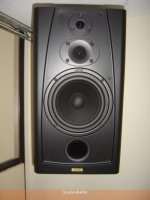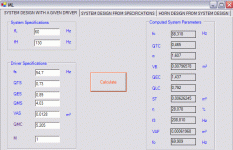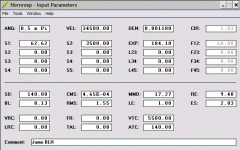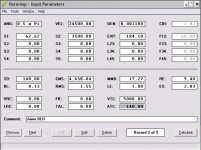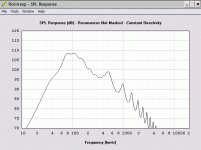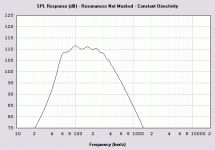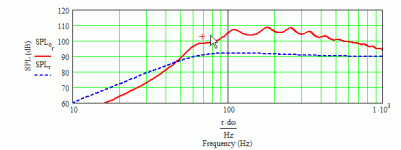Hello everyone,
I have a couple of questions about a 6.5" driver which I would like to use for a BLH.
The driver is from Jamo, type "EC 141 A". After searching on Internet I found that this driver is used in the "Jamo 68" speaker system (see attachment). I measured the T/S parameters myself:
Re = 9,4 Ohm
Fs = 54,7 Hz
Qms = 4,03
Qes = 0,89
Qts = 0,73
Vas ~ 13 L
Sd ~ 220 cm^2
As you can see on the attachment, the speaker system is vented. The dimensions are 44 x 24 x 24 cm (hxwxd), so the Vb of the system is less than 25 L.
Q1) For vented enclosures the driver should have quite low Qts, in this case the driver doesn't have. Also, Vb is very small compared to results from simulations in WinISD. Why does Jamo use a driver which isn't 'optimal' for this speaker system?
Q2) I'm not sure what type of enclosure will be suitable for this driver. Fs is too high for sealed, Qts is too high for vented, bandpass isn't an option, probably dipole won't work (low xmax, small driver), FLH isn't an option (no direct radiator). I think only TL and BLH are suitable, or am I wrong here?
For building a BLH, I got the following questions:
Q3) I'm not sure if a BLH will work well with this driver, because the horn will boost the low frequencies. Probably there will be too much bass compared to other, direct radiated frequencies. I think the bass will be 'overpowered'. Could I get problems with this?
Q4) For this driver Leach's math gives a throat of about 62 cm^2. This a compression ratio of 3,5 : 1. Is it too high and if so, what problems will I get because of this? I tried different throat surfaces and throat chamber sizes, but it seems that 62 cm^2 is the most optimal...
I hope somebody could answer these questions. Thanks in advance.
Regards
Erwin
I have a couple of questions about a 6.5" driver which I would like to use for a BLH.
The driver is from Jamo, type "EC 141 A". After searching on Internet I found that this driver is used in the "Jamo 68" speaker system (see attachment). I measured the T/S parameters myself:
Re = 9,4 Ohm
Fs = 54,7 Hz
Qms = 4,03
Qes = 0,89
Qts = 0,73
Vas ~ 13 L
Sd ~ 220 cm^2
As you can see on the attachment, the speaker system is vented. The dimensions are 44 x 24 x 24 cm (hxwxd), so the Vb of the system is less than 25 L.
Q1) For vented enclosures the driver should have quite low Qts, in this case the driver doesn't have. Also, Vb is very small compared to results from simulations in WinISD. Why does Jamo use a driver which isn't 'optimal' for this speaker system?
Q2) I'm not sure what type of enclosure will be suitable for this driver. Fs is too high for sealed, Qts is too high for vented, bandpass isn't an option, probably dipole won't work (low xmax, small driver), FLH isn't an option (no direct radiator). I think only TL and BLH are suitable, or am I wrong here?
For building a BLH, I got the following questions:
Q3) I'm not sure if a BLH will work well with this driver, because the horn will boost the low frequencies. Probably there will be too much bass compared to other, direct radiated frequencies. I think the bass will be 'overpowered'. Could I get problems with this?
Q4) For this driver Leach's math gives a throat of about 62 cm^2. This a compression ratio of 3,5 : 1. Is it too high and if so, what problems will I get because of this? I tried different throat surfaces and throat chamber sizes, but it seems that 62 cm^2 is the most optimal...
I hope somebody could answer these questions. Thanks in advance.
Regards
Erwin
Attachments
You could do a TL, but you should provide parameters for BL first.
Are you shure that you measured this parameters correctly? Qt is too high for vented box, but I wouldn't be suprised if they really did put such a high Q driver in vented box, it wouldn't be a first case in history
of loudspeaker making.
Are you shure that you measured this parameters correctly? Qt is too high for vented box, but I wouldn't be suprised if they really did put such a high Q driver in vented box, it wouldn't be a first case in history
of loudspeaker making.
Tomac said:You could do a TL, but you should provide parameters for BL first.
Are you shure that you measured this parameters correctly? Qt is too high for vented box, but I wouldn't be suprised if they really did put such a high Q driver in vented box, it wouldn't be a first case in history
of loudspeaker making.
I'm sure I measured the drivers correctly; I repeated the procedure four times, the results were the same.
Here's a complete list of parameters for this driver:
Re = 9,4 [Ohm]
Fs = 54,7 [Hz]
Qms = 4,03
Qes = 0,89
Qts = 0,73
Vas ~ 13 [L]
Sd ~ 140 [cm^2]
Cms = 4,72 * 10^(-4) [m/newton]
Mmd = 17 [g]
BL = 8,07 [tesla.m]
Rms = 1,53 [newton.sec/m]
Greets!
Q1) Don't have a clue. Possibly it's severely underdamped to make its own acoustic BSC. Is it well stuffed, making it ~aperiodic, yielding a ~sealed alignment with gain? The vent size implies this.
Q2) Sounds good to me, though add aperiodic.
Q3) This depends on the horn design, but due to the high Qes, done right, it will be huge.
Q4) Way too high for a typical HIFI driver if FLH, with ~2:1 my limit, but this is a BLH, so we want to look at what sort of vent performance it has in a BR of whatever the filter chamber's Vb is. BTW, I get radically different specs, so what did you input?
Regardless, a MLTL looks pretty good and can be fine tuned with vent damping if need be:
L = 63.41"
zdriver = 21.56"
zport = 60"
SO/SL = 81.21"^2
rport = 1.75"
Lport = 0.75"
This puts the woofer up high enough to mount the HF below it and may not need any BSC once its Le midbass 'hump' and room effect is factored in.
GM
Q1) Don't have a clue. Possibly it's severely underdamped to make its own acoustic BSC. Is it well stuffed, making it ~aperiodic, yielding a ~sealed alignment with gain? The vent size implies this.
Q2) Sounds good to me, though add aperiodic.
Q3) This depends on the horn design, but due to the high Qes, done right, it will be huge.
Q4) Way too high for a typical HIFI driver if FLH, with ~2:1 my limit, but this is a BLH, so we want to look at what sort of vent performance it has in a BR of whatever the filter chamber's Vb is. BTW, I get radically different specs, so what did you input?
Regardless, a MLTL looks pretty good and can be fine tuned with vent damping if need be:
L = 63.41"
zdriver = 21.56"
zport = 60"
SO/SL = 81.21"^2
rport = 1.75"
Lport = 0.75"
This puts the woofer up high enough to mount the HF below it and may not need any BSC once its Le midbass 'hump' and room effect is factored in.
GM
Thanks for your reply GM!
I don't know if the speaker system is stuffed, the only 'information' I've got so far is this picture...
I'm not an expert in horn-design... Could you tell me how to do this? Because usually I don't get a nice response when I change throat en throat chamber dimensions, which I calculated with Leach's math.
The first attachment is from ML's program, which applies Leach's math. The second from HornResp.
I'll try your MLTL suggestion.
BTW, is it possible to calculate Le (when the impedance at 1 kHz is known) ?
thanks again.
Q1) Don't have a clue. Possibly it's severely underdamped to make its own acoustic BSC. Is it well stuffed, making it ~aperiodic, yielding a ~sealed alignment with gain? The vent size implies this.
I don't know if the speaker system is stuffed, the only 'information' I've got so far is this picture...
Q3) This depends on the horn design, but due to the high Qes, done right, it will be huge.
I'm not an expert in horn-design... Could you tell me how to do this? Because usually I don't get a nice response when I change throat en throat chamber dimensions, which I calculated with Leach's math.
Q4) Way too high for a typical HIFI driver if FLH, with ~2:1 my limit, but this is a BLH, so we want to look at what sort of vent performance it has in a BR of whatever the filter chamber's Vb is. BTW, I get radically different specs, so what did you input?
The first attachment is from ML's program, which applies Leach's math. The second from HornResp.
I'll try your MLTL suggestion.
BTW, is it possible to calculate Le (when the impedance at 1 kHz is known) ?
thanks again.
Attachments
Greets!
You're welcome!
Too much to type, but search for BLH in various forums for mine and other designer's thoughts. Your main problem though is Leach is calcing a FLH, so you have to juggle the variables until it calcs at least a large room sized Vb value. Think low flare frequency (Fc) and ~hyperbolic flare factor (M).
Le (mH) = [(Zxo^2-DCR^2)^0.5/(2*pi*Fxo)]*1000
Where:
Fxo = some frequency point away from Fs
Zxo = impedance at Fxo
Dcr = Re
GM
You're welcome!
Too much to type, but search for BLH in various forums for mine and other designer's thoughts. Your main problem though is Leach is calcing a FLH, so you have to juggle the variables until it calcs at least a large room sized Vb value. Think low flare frequency (Fc) and ~hyperbolic flare factor (M).
Le (mH) = [(Zxo^2-DCR^2)^0.5/(2*pi*Fxo)]*1000
Where:
Fxo = some frequency point away from Fs
Zxo = impedance at Fxo
Dcr = Re
GM
Tomac said:You could do a classic TL with constant cross section area of 3 Sd, 200cm long.
For the same line length 3:1 taper is also possible, if you strive for a smaller box and litlle better impulse response. Presonally, I would choose a 3:1 taper over a straight line.
good luck
Thank you for the suggestion. I already experimented a bit with TL lengths and surfaces in MJK's spreadsheets, but there were quite a lot dips and peaks in the response..
GM said:
Too much to type, but search for BLH in various forums for mine and other designer's thoughts. Your main problem though is Leach is calcing a FLH, so you have to juggle the variables until it calcs at least a large room sized Vb value. Think low flare frequency (Fc) and ~hyperbolic flare factor (M).
For my current HornResp simulations I used the throat surface calculated with Leach's formula's, then I adjusted the throat chamber volume (VTC) until I got a decent response. The rear chamber volume (VRC) is 0 (for BLHs), which allows the use of the Back-Horn Tool when showing the SPL graph.
It seems 'impossible' to drop SPL below ~108 dB by changing throat surface and throat chamber volume in HornResp...
I added 2 screenshots of my current simulations (Fl = 60; Fh = 130).
Le (mH) = [(Zxo^2-DCR^2)^0.5/(2*pi*Fxo)]*1000
Where:
Fxo = some frequency point away from Fs
Zxo = impedance at Fxo
Dcr = Re
Thanks for sharing!
regards
Attachments
Greets!
You're welcome!
That ought to tell you something.
I don't follow, why talk about BLH, then sim FLH? Anyway, this driver can't handle a FLH's compression in the 60-130 Hz BW at any useful power rating due to the high Qes and the effects of its Le, though you'll have to build/measure one to find out just how much.
GM
You're welcome!
That ought to tell you something.
I don't follow, why talk about BLH, then sim FLH? Anyway, this driver can't handle a FLH's compression in the 60-130 Hz BW at any useful power rating due to the high Qes and the effects of its Le, though you'll have to build/measure one to find out just how much.
GM
GM said:Anyway, this driver can't handle a FLH's compression in the 60-130 Hz BW at any useful power rating due to the high Qes and the effects of its Le
:O I built a FLH some time ago with a very cheap car audio driver:
Fs = 54,5
Qms = 5,88
Qes = 1
Qts = 0,86
Vas = 20,54 L
BL = 6,7 T.m
Sd ~ 220 cm^2 ( 8" )
Fl = 63
Fh = 140
VRC = 10,6 L
VTC ~ 1,2 L
exponential
It works very well, even at quite high power ratings. It's a bit confusing...
These are the correct parameters:
Driver:
Re = 4,65 Ohm
Fs = 54,5 Hz
Qms = 5,88
Qes = 1
Qts = 0,86
Vas = 20,54 L
Sd ~ 220 cm^2
Pe = 350 W
Cms = 3,02 . 10^(-4) m/newton
Mmd = 26,4 g
BL = 6,71 tesla.m
Rms = 1,64 newton.sec/m
xmax ~ 7 mm (estimation)
Le = unknown
Cone material = ?? (looks a bit like thick paper, it seems it's cheap and quite strong)
Design:
Fl = 63 Hz
Fh = 140 Hz
throat area ~ 83 cm^2
mouth area ~ 2983 cm^2
axial length ~ 156 cm
M=1 (exponential)
VRC ~ 10,6 L
LRC ~ 10,6 cm
No damping material is used
VTC ~ 1,4 L
ATC ~ 1000 cm^2
Constant width = 40 cm
Mouth area (wxh)= 40 x 75 cm
Material is 18 mm MDF
There are 3 bends of 90 degrees, partly based on J H Sheerin's hornloaded subwoofer
Please tell me if I forgot to mention important things.
Thanks in advance.
Driver:
Re = 4,65 Ohm
Fs = 54,5 Hz
Qms = 5,88
Qes = 1
Qts = 0,86
Vas = 20,54 L
Sd ~ 220 cm^2
Pe = 350 W
Cms = 3,02 . 10^(-4) m/newton
Mmd = 26,4 g
BL = 6,71 tesla.m
Rms = 1,64 newton.sec/m
xmax ~ 7 mm (estimation)
Le = unknown
Cone material = ?? (looks a bit like thick paper, it seems it's cheap and quite strong)
Design:
Fl = 63 Hz
Fh = 140 Hz
throat area ~ 83 cm^2
mouth area ~ 2983 cm^2
axial length ~ 156 cm
M=1 (exponential)
VRC ~ 10,6 L
LRC ~ 10,6 cm
No damping material is used
VTC ~ 1,4 L
ATC ~ 1000 cm^2
Constant width = 40 cm
Mouth area (wxh)= 40 x 75 cm
Material is 18 mm MDF
There are 3 bends of 90 degrees, partly based on J H Sheerin's hornloaded subwoofer
Please tell me if I forgot to mention important things.
Thanks in advance.
Greets!
A FR plot would be nice as well as the driver's PE and how much power you've measured at the horn terminals, but the bottom line is that while you may be satisfied with its performance, it can't compete with a lower Qes/low Le driver optimized for this BW in the same size horn since the high Qes will require much more acoustic efficiency due to its relatively weaker motor and its relatively high CR (for a point source driver) will cause thermal power compression at a lower power. Then there's the effects of a high Le.......
Bottom line, Leach's math allowed you to make a horn that works well enough for you using a driver that without it would be dismissed 'out of hand' as being totally unsuitable, but it's not one I would recommend for the app, hence my previous remark.
BTW, for my records, which driver is this?
GM
A FR plot would be nice as well as the driver's PE and how much power you've measured at the horn terminals, but the bottom line is that while you may be satisfied with its performance, it can't compete with a lower Qes/low Le driver optimized for this BW in the same size horn since the high Qes will require much more acoustic efficiency due to its relatively weaker motor and its relatively high CR (for a point source driver) will cause thermal power compression at a lower power. Then there's the effects of a high Le.......
Bottom line, Leach's math allowed you to make a horn that works well enough for you using a driver that without it would be dismissed 'out of hand' as being totally unsuitable, but it's not one I would recommend for the app, hence my previous remark.
BTW, for my records, which driver is this?
GM
Greets!
You're welcome!
That's about what I expected to see, lower gain below ~100 Hz than for an optimized horn in a similar bulk package and a somewhat 'humped' midbass due to the high Qes, which its Le will increase a bit, though as more power is applied the FR will become more non-linear than one with a more powerful, low Le driver.
Still, lots of 'bang/buck' satisfaction there, with a FR similar to a Karlson, but with much more gain, so much higher 'slam' factor. Gotta love Leach's math's ability to reclaim 'junk' drivers. Cool.
Thanks for sharing!
GM
You're welcome!
That's about what I expected to see, lower gain below ~100 Hz than for an optimized horn in a similar bulk package and a somewhat 'humped' midbass due to the high Qes, which its Le will increase a bit, though as more power is applied the FR will become more non-linear than one with a more powerful, low Le driver.
Still, lots of 'bang/buck' satisfaction there, with a FR similar to a Karlson, but with much more gain, so much higher 'slam' factor. Gotta love Leach's math's ability to reclaim 'junk' drivers. Cool.
Thanks for sharing!
GM
Interesting. I think MJK's BLH speadsheet is more reliable than HornResp when designing the horn section, because it takes bends and other factors into account.
Anyway, the horn's efficiency seems a bit lower on your graph. Is this because I used 2.83 V for this 4 Ohm system?
Anyway, the horn's efficiency seems a bit lower on your graph. Is this because I used 2.83 V for this 4 Ohm system?
- Status
- This old topic is closed. If you want to reopen this topic, contact a moderator using the "Report Post" button.
- Home
- Loudspeakers
- Multi-Way
- Questions about driver and/for BLHs
